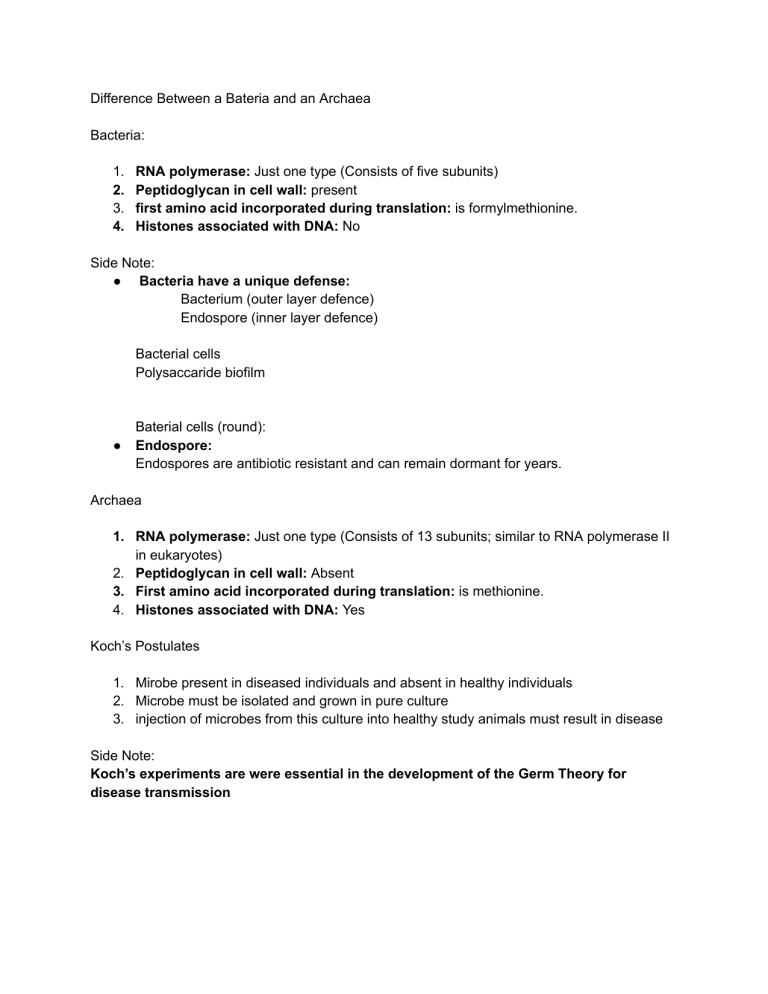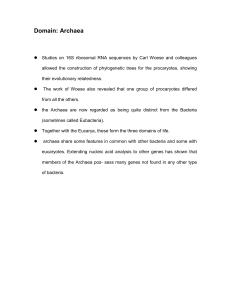Bacteria vs. Archaea: Key Differences & Characteristics
advertisement

Difference Between a Bateria and an Archaea Bacteria: 1. 2. 3. 4. RNA polymerase: Just one type (Consists of five subunits) Peptidoglycan in cell wall: present first amino acid incorporated during translation: is formylmethionine. Histones associated with DNA: No Side Note: ● Bacteria have a unique defense: Bacterium (outer layer defence) Endospore (inner layer defence) Bacterial cells Polysaccaride biofilm ● Baterial cells (round): Endospore: Endospores are antibiotic resistant and can remain dormant for years. Archaea 1. RNA polymerase: Just one type (Consists of 13 subunits; similar to RNA polymerase II in eukaryotes) 2. Peptidoglycan in cell wall: Absent 3. First amino acid incorporated during translation: is methionine. 4. Histones associated with DNA: Yes Koch’s Postulates 1. Mirobe present in diseased individuals and absent in healthy individuals 2. Microbe must be isolated and grown in pure culture 3. injection of microbes from this culture into healthy study animals must result in disease Side Note: Koch’s experiments are were essential in the development of the Germ Theory for disease transmission Morphological Diversity among Bacteria is extensive 1. Size varies: Most bacteria are about 1 µm in diameter, but some are much larger 2. Sape varies From rods to spheres to spirals in some species, cells adhere to form chains (Rods, chains of spheres and spirals) 3. Motility varies Some bateria are nonmotile, butswimming and gliding are common Gram staining distinguishes two types of cell walls in bacteria. 1. Gram-positive: Gram-positive cell wall (intense staining) 2. Gram-negative: Gram-negative cell wall (little staining) Gram stains stains the petidoglycan in the cell Sources of Energy (for synthesis of ATP) 1. Cellular respiration: ● Cellular Respiration is based on electron transport chain (glucose is the electron donor, and oxygen is the final electron acceptor) ● This diversity of electron donors and acceptors is why bacteria are good at remediation 2. Cellular respiration or fermentation: 3. Cellular respiration with inorganic compound as electron donor Cyanobacteria Were the First Organisms to Perform Oxygenic Photosynthesis. (~2.3 BYA) Some sulfur bacteria use H2S instead of H2O in their photosynthesis. - a mutation allowed the switch to H2O for oxygenic photosynthesis to evolve - since H2O is so much more abundant than H2S, oxygenic dominates Lateral gene transfer and our gut flora – informs are gut flora about what’s to come • Oligosaccharides in mother’s milk – we are incapable of digesting it – Bacteria line the microvilli of our intestinal lining ● Protects the lining as the gut flora is developed Notes: ● ● ● ● ● ● ● ● all similar to the eukaryotes (Archaea ribosomes are also similar to eukaryotic ribosomes) Some archaea are etremophiles Thermophilic Archaea are responsible for the yellow color of the yellow stone in yellow stone National Park Thermophilic Archaea are extremophiles Almost all bacteria are beneficial. Only a small fraction cause disease. Bacillus (rods) Coccus( spheres) Spirillus (spiral) There are almost 700 Anoxic dead zones in our oceans




